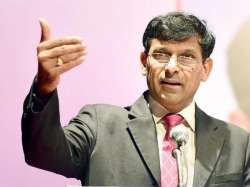Raghuram Rajan to announce RBI monetary policy review on Tuesday
Mumbai:Reserve Bank of India governor Raghuram Rajan is due to announce the second bi-monthly monetary policy review of the fiscal on Tuesday, at a time when he has become the focus of controversy sparked by

Mumbai:Reserve Bank of India governor Raghuram Rajan is due to announce the second bi-monthly monetary policy review of the fiscal on Tuesday, at a time when he has become the focus of controversy sparked by attacks for failure to lower interest rates and boost the economy.
Making RBI’s first policy review of the finacial year in April, Rajan had cut the central bank’s repo, or short term rate at which it lends to commercial banks, by 25 basis points to 6.5 per cent.
It also introduced a host of measures to smoothen liquidity supply so that banks can lend to the productive sectors and indicated accommodative stance going ahead. RBI narrowed the policy rate corridor to 0.50 per cent from the earlier 1 percentage point, which resulted in the reverse repo rate - at which banks can park excess funds with the RBI - being reset at 6 per cent.
Expectations of a rate cut at RBI’s Tuesday policy meeting are lower after retail inflation rose to 5.39 per cent in April, which was above Rajan’s near-term target of 5 per cent by March 2017.
However, latest official data showed India was one of the world’s fastest growing economies in the March quarter, with GDP growing at a rate of 7.9 per cent.
On the other hand, making the case for a rate cut, growth in India’s private sector output declined in May as manufacturing and service sectors lost momentum in conditions of softer domestic demand, while services slowed sharply to a six-month low, a business survey on performance of the services sector showed on Friday.
The Nikkei Manufacturing Purchasing Managers’ Index released on Thursday rose marginally to 50.7 in May from 50.5 in April.
“Following broadly stagnant levels in April, order book volumes increased during May. The pace of expansion was, however, only slight and well below its long-term average,” the report said.
Rajan took charge of the RBI in 2013 at a time when the US Federal Reserve had declared its intent to wind down its stimulus programme, following which the rupee plunged in value with respect to the US dollar on fears of a spiralling current account deficit.
Through a series of measures, Rajan managed to stabilise the Indian currency that also brought back investors.
Meanwhile, with Rajan’s current three-year term ending in the first week of September, an online petition pushing for a second term for him has gone viral and has gathered close to 60,000 signatures in support.
The petition, filed last month on change.org by Bengaluru-based Rajesh Palaria, has been logging support at a fast rate and had recorded 57,000 votes by Sunday.
Many Indian corporate leaders too have recently voiced their preference for an extension in Rajan’s tenure by the government.